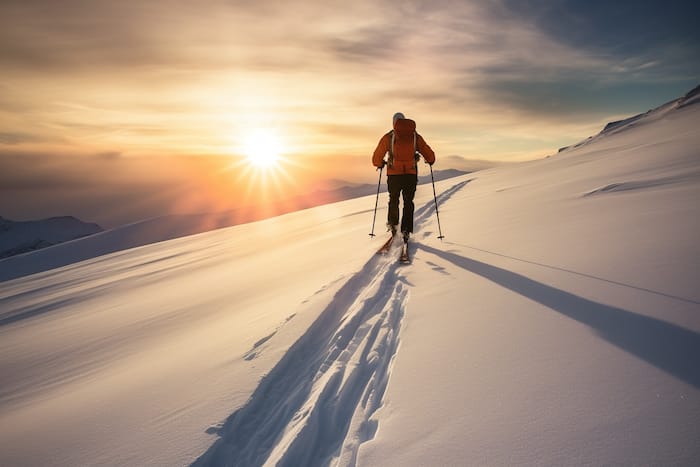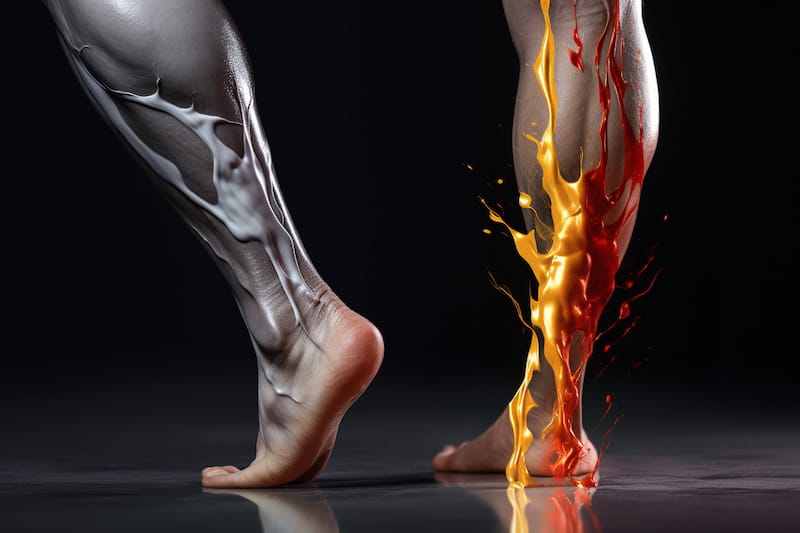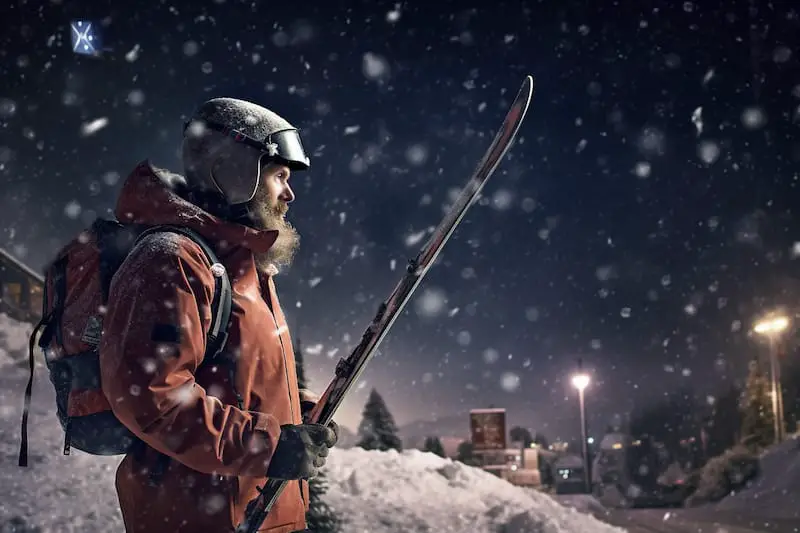Skiing can be an exhilarating winter activity, but it also exposes your skin to the harsh elements of nature. One of the most common concerns for skiers is windburn, which refers to the irritation and redness caused by prolonged exposure to cold wind.
Windburn can be painful and uncomfortable, causing dryness, itching, and even blistering in severe cases. Windburn occurs when the skin loses its protective oils and moisture due to exposure to cold winds.
It strips away the natural barrier of fatty acids that help keep our skin hydrated and soft. When the barrier is broken down, irritants like wind and cold weather penetrate into deeper layers of our skin, causing inflammation and redness.
Skiers are particularly prone to windburn because they are exposed to high altitudes where temperatures can rapidly drop. Additionally, skiing usually involves traveling at high speeds which increase wind friction on your face.
Therefore it’s essential for skiers to take necessary measures in protecting their skin against harsh winter conditions while skiing. In this article, we will share some tips on how you can prevent windburn while skiing so that you can enjoy this exciting sport without worrying about your skin’s health or comfort.
Dress Appropriately
Layering Clothing to Protect Your Skin from Wind Exposure
One of the most critical steps to prevent windburn while skiing is to dress appropriately. Layering is the key, and it involves wearing multiple thin layers rather than one thick layer of clothing.
The reason behind layering is that it allows you to adjust your clothing as needed by removing or adding a layer depending on the weather conditions, and also provides insulation that keeps you warm while preventing windburn. When layering clothing, choose a base layer made from synthetic fabric such as polyester or nylon rather than cotton which will absorb sweat and leave you wet and cold.
Next, add an insulating mid-layer made from wool or fleece that traps warmth in without adding bulk. Add an outer shell made of waterproof and breathable material such as Gore-Tex that protects you from wind exposure.
Choosing the Right Fabrics for Warmth and Protection
Choosing the right fabrics for your ski clothes plays a crucial role in protecting your skin from windburn. Ideally, go for materials that are dense enough to block out cold air but still breathable enough to allow for moisture evaporation.
Merino wool is an excellent choice for baselayers because it wicks away sweat from your skin while retaining heat even when wet. Synthetic materials like polyester or nylon are ideal mid-layers since they provide insulation without trapping moisture next to your skin.
As for outerwear fabrics, look for something tough yet lightweight like Gore-Tex or eVent fabrics that can resist water penetration while ensuring breathability at the same time. With the right garment choices, you’ll be able to prevent windburn while keeping yourself comfortable all day long on the slopes!
Use Sunscreen and Lip Balm
Protecting Your Skin from UV Radiation and Windburn
Skiing is a thrilling winter sport that combines speed, skill, and endurance. However, it also exposes your skin to the harsh elements of winter weather, including the sun’s UV radiation and cold winds. To protect your skin from these harmful environmental factors, you should apply sunscreen to exposed areas of your face and body before hitting the slopes.
Even on cloudy days, UV rays can penetrate through clouds and cause skin damage if left unprotected. Therefore, it’s important to apply a broad-spectrum sunscreen with an SPF rating of at least 30.
When choosing a sunscreen for skiing, look for one that is water-resistant and sweat-resistant to ensure maximum protection during physical activity. Additionally, consider using a moisturizing sunscreen that contains ingredients like hyaluronic acid or glycerin to prevent dryness and maintain hydration in your skin.
Protecting Your Lips from Chapping
In addition to sunscreen, you should also use lip balm with SPF protection to prevent windburn on your lips. The skin on our lips is thinner than other parts of our face and body, making them more susceptible to chapping in cold weather conditions. When exposed to windy conditions while skiing at high speeds or elevations above sea level where the air is dry, our lips can become irritated or cracked due to moisture loss.
To prevent this discomfort while skiing down black diamond slopes or gliding along groomed trails in beautiful mountainous terrain covered with fresh powder snowflakes glistening under blue skies overhead surrounded by pines trees laden with snow – use lip balm regularly throughout the day as needed. Choose a lip balm with an SPF rating of at least 15-30 for added protection from UV radiation.
Look for lip balms that contain ingredients like beeswax, shea butter, or coconut oil to lock in moisture and soothe dry, cracked lips. Applying lip balm before skiing and during breaks can help keep your lips feeling soft and comfortable all day long.
Wear Goggles or Sunglasses
Protecting eyes from wind and sun exposure
When it comes to skiing, protecting your eyes from the sun and wind is just as crucial as keeping your skin safe. The harsh glare of snow can cause damage to your eyes, while cold winds can dry them out, leading to irritation and redness.
That’s why wearing goggles or sunglasses is a must while skiing. Goggles provide complete protection for your eyes against wind, snow, and glare.
They also create a barrier between your face and the cold air, preventing windburn. On the other hand, sunglasses are a great option on sunny days when there’s no need for additional eye protection from snow or wind.
Choosing the right type of eyewear for skiing
When choosing eyewear for skiing, there are several factors to consider. The first thing to keep in mind is functionality over fashion.
Make sure you pick goggles or sunglasses that fit well around your head without any gaps so that they stay in place while you ski. You’ll also want to think about lens color.
Yellow or orange lenses are ideal for low-light conditions because they enhance contrast and help you see better in cloudy weather. Darker lenses like brown or grey are perfect for sunny days because they reduce glare and prevent eye strain.
Last but not least, consider purchasing anti-fogging goggles or sunglasses with vents that allow airflow to prevent fogging up during activity. There’s nothing worse than having foggy goggles that obstruct your vision while skiing down a mountain!
Wearing proper eyewear is essential when hitting the slopes. Whether you prefer goggles or sunglasses depends on weather conditions and personal preference but ultimately both provide protection against harmful UV rays and dry winds associated with winter sport activities like skiing!
Take Breaks Indoors
While skiing is a fantastic way to get your blood pumping and enjoy the winter wonderland, it’s essential to take breaks. Not only can you relax and recharge, but you’ll also prevent windburn by avoiding prolonged exposure to cold winds. When you ski in cold weather, the wind can strip away the natural oils in your skin, leaving it dry and cracked; therefore, taking breaks indoors is critical to preventing this.
One of the best ways to ensure that you take breaks while out skiing is by planning ahead. Look up coffee shops or restaurants along the ski route where you can warm up inside for a few minutes.
If outdoor seating is available with proper spacing and safety guidelines are followed, consider enjoying a hot beverage or grab an indoor table if possible for added warmth. Remember that while taking regular breaks indoors may seem like slowing down your skiing routine, these quick stops will benefit your health long term and ensure optimal performance when back on the slopes.
Avoiding prolonged exposure to cold winds
It’s tough to resist staying outside when there’s fresh powder on the slopes – however, getting caught in prolonged exposure to cold winds leads to windburn quickly. Windburn occurs when there is prolonged skin exposure to cold temperatures and high winds resulting in redness and irritation.
The combination of low humidity levels at high altitudes makes skin particularly vulnerable during winter sports activities like skiing. If you’re starting to feel numbness or tingling sensations in your hands or face while skiing, it’s time for a break indoors.
If left untreated, frostbite could occur from staying outside too long under such conditions (especially if wet). Remembering that short sessions outdoors with proper clothing are safer than extended periods without enough protection can help prevent windburn while enjoying winter sports activities.
Taking Breaks Indoors To Warm Up And Prevent Windburn
Taking breaks indoors to warm up and prevent windburn is essential to keep the body’s core temperature stable. When you get cold, your body will start to shiver, which is an involuntary response that helps create internal heat. The more you shiver, the colder you become because your body is sending signals that it needs warmth.
Therefore, finding a place to warm up indoors becomes necessary. Indoor heating systems are used in many places where winter sports are popular for precisely this reason.
Whenever possible, take the time to warm up inside; if there aren’t any indoor options nearby on your route, consider taking a break in your car with the heater running for added warmth and protection from cold winds. Remember that taking breaks indoors while skiing will help prevent windburn and keep you comfortable and energized during your skiing trip.
Hydrate Properly
Drinking plenty of water before, during, and after skiing
One of the most important things to remember while skiing is to stay hydrated. It’s easy to forget about drinking water when you’re having fun on the slopes, but staying hydrated is crucial for your body and skin.
Make sure to drink plenty of water before you hit the slopes, during your breaks, and after you finish skiing for the day. When skiing at higher altitudes, it’s even more important to stay hydrated as your body loses moisture faster due to dry air.
Dehydration can lead to dry skin, chapped lips, fatigue and headaches – all things that can ruin a good ski trip. Bring a reusable water bottle with you or take advantage of the warming huts that are typically located on many ski trails.
Keeping skin hydrated to prevent dryness and cracking
Not only is it important to hydrate internally by drinking water but also externally by moisturizing your skin. The cold weather and wind can quickly lead to dryness and cracking of the skin if left untreated.
To keep your skin moisturized while skiing make sure you apply a thick moisturizer before heading out. Choose a moisturizer that is specifically designed for outdoor activities or winter sports as they typically contain ingredients that help retain moisture in harsh conditions.
Don’t forget about your hands – they are often exposed while holding onto ski poles so make sure you use an intensive hand cream too. Another tip is using lip balm with SPF on both lips and cheeks; it creates a barrier between harsh outside conditions and delicate facial tissues which will keep them from drying out so fast.
Drinking enough water throughout the day combined with keeping your skin moisturized with thick creams will help prevent dehydration-related issues such as chapped lips or cracked hands. So don’t forget to pack your water bottle and moisturizer before heading out to the slopes.
Use a Face Mask or Balaclava
Covering the face with a mask or balaclava to protect against windburn
When skiing in cold, windy weather conditions, it’s important to protect not just your skin but also your face. A face mask or balaclava can work wonders in shielding your nose, mouth, and cheeks from the biting wind. These items are especially useful when skiing at high altitudes where the air is thin and the wind chill factor is high.
A good face mask should cover your entire face except for your eyes. It should be snug enough to stay in place but not too tight that it causes discomfort.
A balaclava, on the other hand, is a type of headgear that covers your head and neck with an opening for the eyes. This type of gear provides more warmth than a face mask and can also be used as a hat or neck warmer when pulled down.
Choosing the right material for warmth and breathability
When selecting a face mask or balaclava, consider its material as this can affect both warmth and breathability. Some materials such as fleece are excellent at keeping you warm but may cause you to overheat if they are too thick. Others like neoprene are lightweight and breathable but may not provide enough insulation in very cold conditions.
A popular choice for skiers is merino wool as it provides excellent insulation without being bulky or heavy. It’s also naturally moisture-wicking which helps keep sweat away from the skin – an important factor when skiing as dampness can quickly lead to coldness if left unchecked.
Other materials worth considering include synthetic fabrics like polyester which are lightweight yet warm; silk which feels soft against the skin; and Gore-tex which is waterproof yet breathable. Overall, choosing the right material for a face mask or balaclava comes down to personal preference and needs.
Consider the weather conditions you’ll be skiing in, how much warmth you require, and how breathable you need the material to be. With the right gear, you can enjoy skiing without worrying about windburn or coldness interfering with your fun.
Final Thoughts: Tips for Preventing Windburn While Skiing
Skiing is an exhilarating and fun winter activity, but it also exposes your skin to harsh winds that can cause windburn. This painful condition can lead to dry, red, and itchy skin that lasts for days.
But fear not, by following these tips and tricks, you can prevent windburn while skiing and enjoy your time on the slopes. To begin with, dressing appropriately is key in preventing windburn.
Layering clothing helps protect your skin from the harsh winds. Choosing fabrics like wool or synthetic blends can help keep you warm while also offering protection from the wind.
It’s important to avoid cotton as it absorbs moisture that can make you feel colder. Another way to prevent windburn is by using sunscreen and lip balm with SPF protection.
Even on cloudy days, UV rays from the sun can still damage your skin. Furthermore, using a lip balm with SPF helps protect your lips as they are especially susceptible to chapping due to exposure.
Take breaks indoors to warm up! Avoid prolonged exposure to cold winds.
Try taking breaks in heated shelters or warming huts located at most ski resorts. This will give your body time to warm up and reduce the risk of getting windburn or frostbite.
Enjoying winter sports doesn’t have to mean sacrificing healthy skin! By following these tips like layering clothing appropriately for warmth and protection against harsh winds; putting on sunscreen regularly; taking breaks indoors if necessary so as not expose oneself too much; protecting one’s eyes with goggles or sunglasses when necessary; drinking plenty of water before during after skiing sessions (especially important given how quickly dehydration occurs in colder weather), among other things—you’ll be able to enjoy all kinds of outdoor activities without having to worry about getting chapped cheeks.


